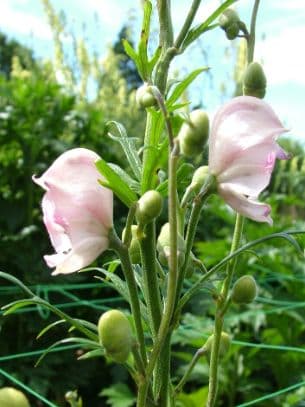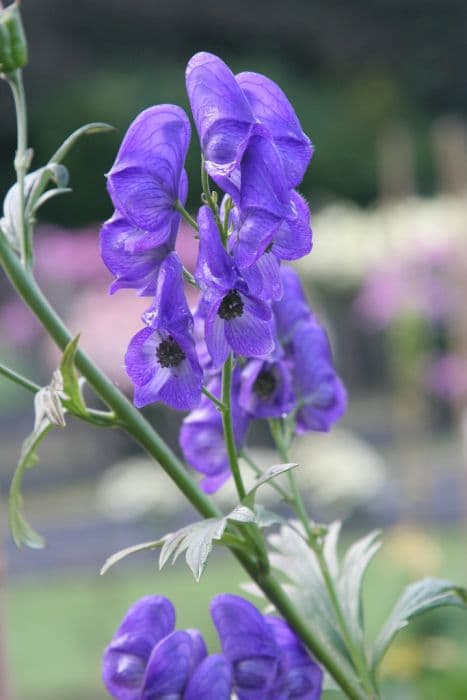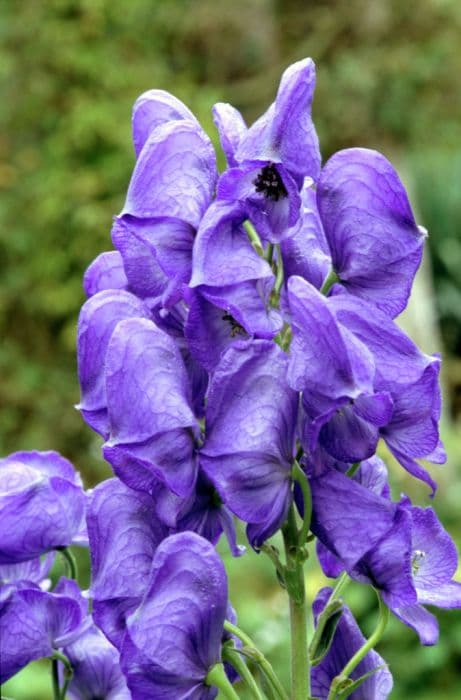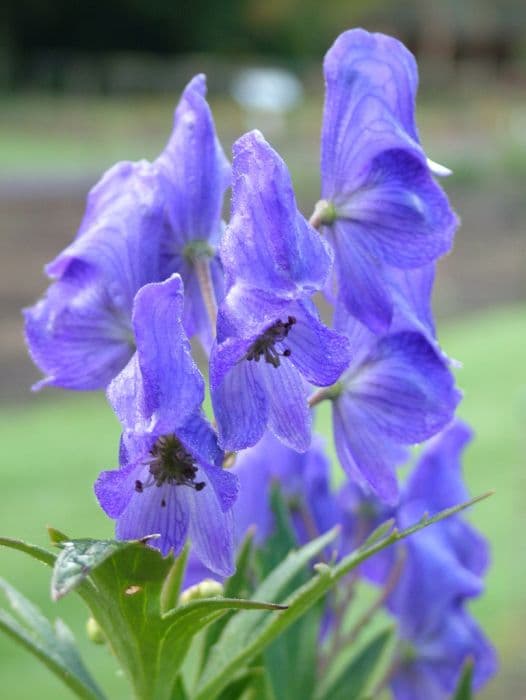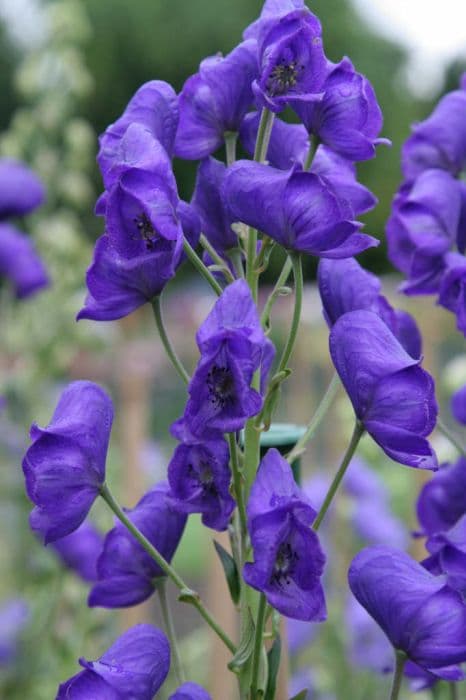Little Nell Clematis Clematis 'Little Nell' (Vt)

ABOUT
Clematis 'Little Nell' boasts an appealing aesthetic with a cascade of delicate flowers. The blossoms present a soft palette, usually showcasing creamy-white petals which may carry a hint of pale green or light pink. At the center, a puff of prominent stamen provides a striking contrast, typically in a rich, yellow hue. This contrast makes the flowers visually striking. The petals are often rounded with a slightly ruffled or wavy edge, adding to the charm of the blossoms that appear during blooming periods. The foliage of the Clematis 'Little Nell' creates an elegant backdrop for the flowers. The leaves are usually mid-green in color and divided into leaflets, which are arranged in pairs along the stems. This results in a lush, green canvas throughout the growing season. As with many Clematis varieties, the shape and texture of the leaves add to the plant's overall ornamental value. Overall, Clematis 'Little Nell' carries a delightful aesthetic that is favored by gardeners looking to add a touch of elegance and soft color to their garden spaces. The contrast between the creamy-white flowers and the green foliage, as well as the gentle form of the blooms, create an enchanting display that can complement a wide range of garden designs and plant companions.
About this plant
 Names
NamesFamily
Ranunculaceae.
Synonyms
Little Nell Clematis, Vermont Clematis.
Common names
Clematis 'Little Nell' (Vt).
 Toxicity
ToxicityTo humans
Clematis, including the variety 'Little Nell', is known to be mildly toxic to humans if ingested. The compound called protoanemonin, which is found in clematis plants, can cause severe mouth pain and ulcers if chewed or swallowed. Additionally, ingestion can lead to symptoms such as nausea, vomiting, diarrhea, and in some cases, salivation. Skin contact with the plant's sap may also result in dermatitis for those with sensitive skin. It is important to handle these plants with care and to ensure that they are not ingested.
To pets
Clematis, including 'Little Nell', is also considered toxic to pets. The compound protoanemonin can cause similar symptoms in pets as in humans if ingested. Symptoms of clematis poisoning in pets may include drooling, vomiting, diarrhea, and in severe cases, difficulty breathing or convulsions. It's essential to prevent pets from chewing or ingesting any part of the plant to avoid the possibility of poisoning.
 Characteristics
CharacteristicsLife cycle
Perennials
Foliage type
Deciduous
Color of leaves
Green
Flower color
Mixed
Height
6-8 feet [1.8-2.4 meters]
Spread
3-4 feet [0.9-1.2 meters]
Plant type
Climber
Hardiness zones
4
Native area
Europe
Benefits
 General Benefits
General Benefits- Ornamental Appeal: Clematis 'Little Nell' has attractive, delicate flowers providing visual interest to gardens and outdoor spaces.
- Vertical Gardening: This climbing vine is ideal for adding height and vertical interest to gardens, covering trellises, arbors, and fences.
- Seasonal Color: With its blooming cycle, Clematis 'Little Nell' adds seasonal color to the landscape, typically in late spring to early summer.
- Privacy Screening: Its dense foliage can be used to create natural privacy screens in garden settings.
- Wildlife Attraction: The flowers may attract pollinators such as bees and butterflies, supporting local ecosystems.
- Compact Growth: This cultivar has a more contained growth habit, making it suitable for smaller gardens or spaces.
 Medical Properties
Medical PropertiesThis plant is not used for medical purposes.
 Air-purifying Qualities
Air-purifying QualitiesThis plant is not specifically known for air purifying qualities.
 Other Uses
Other Uses- Clematis can be used for art and craft projects, such as pressing flowers for scrapbooking or making natural dyes for fabrics.
- Gardeners might train Clematis vines to grow over unsightly structures, camouflaging things like old fences or sheds.
- The vine structure of Clematis can offer support for other plants in the garden, serving as a living trellis.
- Clematis flowers can be used in a 'living curtain' by growing them across a wire to create partial shade in a sunny area.
- Dried Clematis vines can serve as rustic decoration elements or as part of a natural wreath when interwoven with other materials.
- During certain celebrations or ceremonies, Clematis blooms could be used for their decorative appeal in arrangements or venue décor.
- In photography, Clematis can be used to create a romantic or whimsical backdrop due to their cascading blooms.
- Creating a natural canopy with Clematis vines can be a habitat enhancement strategy to provide shelter for small wildlife.
- In creative landscaping, Clematis can be used to create color-themed gardens, as they come in various hues.
- When dried, Clematis seed heads can be used in floral arrangements to add an element of interest and contrast.
Interesting Facts
 Feng Shui
Feng ShuiClematis is not used in Feng Shui practice.
 Zodiac Sign Compitability
Zodiac Sign CompitabilityClematis is not used in astrology practice.
 Plant Symbolism
Plant Symbolism- Ingeniousness: Clematis' complex structure and climbing nature reflect cleverness and the ability to think outside the box.
- Mental Beauty: Often associated with the intricacy of the mind, clematis symbolizes the beauty found in intellectual pursuits.
- Artistic Inspiration: With its showy flowers, the clematis is seen as a muse for artists, representing creative inspiration.
- Spiritual Pursuit: The plant's growth towards the sky can symbolize a journey towards spiritual enlightenment or higher understanding.
 Water
WaterClematis 'Little Nell', known commonly as Viticella Clematis, prefers a consistent watering schedule to maintain moist, well-drained soil. It's best to water this plant deeply once a week with about 1 gallon of water, making adjustments for rainfall and weather conditions. During hot, dry periods, you might need to water twice a week. To ensure deep water penetration, water at the base of the plant, avoiding overhead watering to minimize the risk of foliar diseases. In the winter, reduce watering as the plant requires less moisture due to dormancy.
 Light
LightViticella Clematis thrives best in a location where it receives about 6 hours of sunlight daily. Ideally, its base and roots should be shaded, while the foliage and flowers bask in full sun to partial shade. The best spot for this clematis is thus with its feet in the shade and head in the sun. If needed, plant low-growing shrubs or place a mulch near the base to provide the necessary shade.
 Temperature
TemperatureViticella Clematis is hardy and can withstand a range of temperatures, but it grows best when the temperature is between 55°F and 75°F. It can survive minimum winter temperatures down to about -20°F but should be protected from harsh winds. During extreme heat above 90°F, the plant may require additional shade and watering to prevent stress.
 Pruning
PruningPruning encourages healthy growth and flowering in Viticella Clematis. These plants flower on the current year's growth, so prune in late winter or early spring, when buds begin to swell but before active growth resumes. Cut the plant back to about 12 inches above ground level. This heavy pruning ensures a more robust vine with an abundance of blooms. The best time for pruning is between February and March.
 Cleaning
CleaningAs needed
 Soil
SoilClematis 'Little Nell' thrives best in a well-draining soil mix with a pH of around 6.5 to 7.0. A suitable mix can be created using two parts garden soil, one part peat moss or compost, and one part perlite or small bark chips to improve drainage. It is crucial for the soil to remain moist but not waterlogged, so the addition of organic matter like compost will help retain the necessary moisture while allowing excess water to drain away.
 Repotting
RepottingClematis 'Little Nell' typically doesn't need regular repotting and can thrive for years without being disturbed. However, if it outgrows its container or the soil becomes exhausted, repotting every 2-3 years in the spring before the growth season begins is generally advised. When repotting, gently tease out the roots to encourage them to spread into the new soil.
 Humidity & Misting
Humidity & MistingClematis 'Little Nell' prefers a moderate humidity level, which aligns with typical outdoor conditions where it usually thrives. Although it can adjust to the humidity levels found in most homes, an overly dry atmosphere can be counterproductive. Therefore, maintaining humidity levels around 50-60% is ideal for this variety of clematis to flourish.
 Suitable locations
Suitable locationsIndoor
Provide bright indirect light and cool temperatures for indoor growth.
Outdoor
Plant in partial shade, with support for climbing, water regularly.
Hardiness zone
4-9 USDA
 Life cycle
Life cycleClematis 'Little Nell' (Viticella Group), commonly referred to as Clematis 'Little Nell', begins its life cycle as a seed, which after germination, grows into a small plant with a well-developed root system. As it matures, it develops climbing vines that require support to continue vertical growth and may reach heights up to 2-3 meters. During spring and early summer, 'Little Nell' produces numerous small, bell-shaped flowers that are pale blue with a hint of mauve, attracting pollinators to the garden. After flowering, the plant sets seed in fluffy seed heads that can be dispersed by wind or animals, starting the cycle anew if conditions are suitable. During autumn, as temperatures decrease, the plant's growth slows down, and it enters a period of dormancy throughout winter, where less water and maintenance are needed. With the return of warmer weather in spring, Clematis 'Little Nell' resumes active growth, continuing its perennial life cycle.
 Propogation
PropogationPropogation time
Spring-Early Summer
Clematis 'Little Nell', commonly known as Virgin's Bower, is best propagated in spring or early summer. The most popular method is softwood cuttings, where new growth that is not yet firm is selected. A cutting of about 4-6 inches (10-15 cm) long with at least two pairs of leaves is taken just below a leaf node. The lower leaves are removed, and the cut end is dipped in rooting hormone to encourage root development. The cutting is then planted in a well-draining potting mix, ensuring at least one pair of leaves is above the substrate. The pot is placed in a warm, shaded environment, and the substrate is kept consistently moist until roots have established, which may take several weeks. Covering the cutting with a plastic bag can help to retain moisture and humidity, which is beneficial for root growth.

